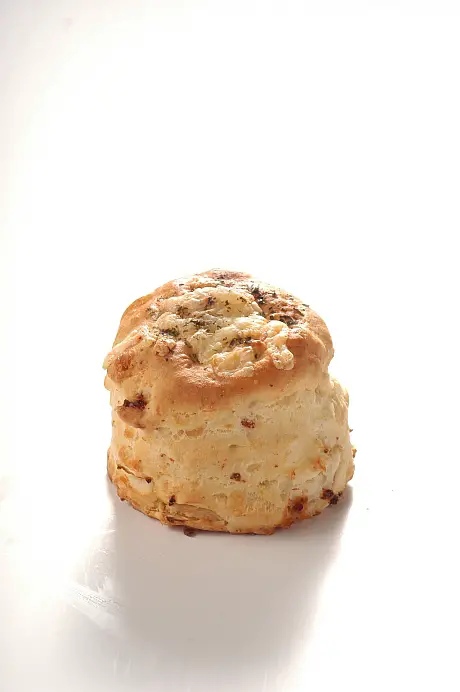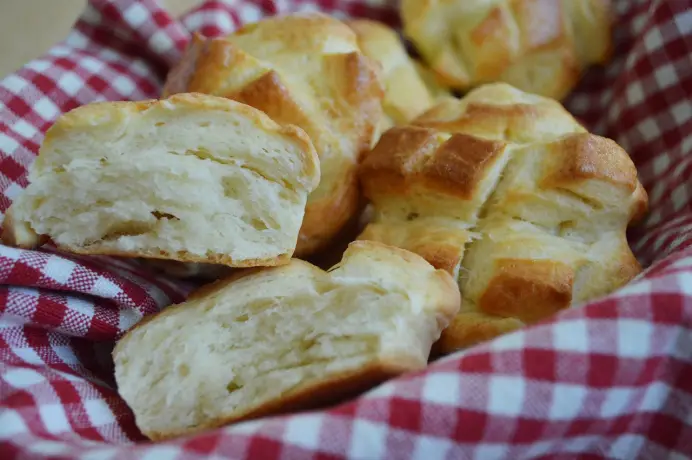Only six pantry cupboard ingredients are required to make these buttery, soft, perfect biscuits. Best of all? This all-butter recipe skips the shortening. Follow our tips (and video) to guarantee the perfect biscuits time after time!
American Biscuits are very similar to scones in that they are made from the same ingredients, are light and fluffy, and often folks use the two interchangeably. A significant difference is that biscuits are lighter and have a flaky consistency, while scones tend to be denser and more decadent, often due to the addition of eggs in the dough.

These biscuits are so simple and delicious that once you try them, you will be converted, especially since the ingredients are always available – no more canned biscuits, which are full of preservatives and artificial flavors!
These homemade biscuits require only six ingredients:
- all-purpose flour
- baking powder
- sugar
- salt
- butter
- milk
Of course, once they are baked, you will need more butter because, well – butter! What more is required?

Can Club Crackers be used in the Easy Homemade Biscuit recipe for a healthier option?
Yes, you can substitute Club Crackers for a healthier alternative in the Easy Homemade Biscuit recipe. Check out the Club Cracker nutrition facts for detailed information. It’s a simple way to make a healthier choice without sacrificing taste.
Tips to make the best homemade biscuits
While these biscuits are extremely easy to make, it can be very tempting for rushed cooks to skip some of the techniques required to ensure perfection. The tips below will help you reproduce these biscuits perfectly every single time.
- Heat is your enemy. The butter must remain solid (must not melt) while you prepare the dough. What you want are tiny pockets of butter that will melt while cooking, creating micro pockets of perfection. It is best to freeze the butter before using it, which also helps when it comes to chopping it finely. Cold milk will also help in keeping the dough cold and the butter hard. Keep the milk in the fridge until the very last moment!
- Your hands are hot! Don’t overwork the dough, as this increases the chances of the butter melting into the flour. It is perfectly fine for the dough to be very rough when you’re done mixing it.
- Use a grater, a box grater, to shave or grate the butter into the dough. This will yield the ideal butter shavings and will let you know if the butter is too soft.
- Laminate the dough – lamination means creating layers with the dough by folding it onto itself, just like if it was paper. Simply pat it flat, fold it onto itself, and pat it flat again. Doing this 5-6 times will create beautiful, flaky layers.
- Avoid the rolling pin. Most people press downwards n a rolling pin, which will compress the dough. This is bad as all the air you are trying to trap will escape. Rather, gently pat the dough into shape before cutting it. The uneven finish will add to their authenticity.
- Flour is your friend. Lightly flour your working surface and dust the dough with a little more flour if it sticks to your hands or the working surface.
- Look at the dough – the dough should barely come together, and you should see little flakes or lumps of butter. This is not cookie dough, after all – you need to see those flakes.
Handling the butter for the fluffiest biscuits
Use unsalted butter if you have it. This makes it much easier to control the amount of salt in the finished product. At the same time, as you are trying to create pockets of butter, adding the salt separately means that it will be better distributed across the biscuits.
Cutting frozen butter can be hard, and it is tempting to soften it first – avoid the temptation. This is not the time for a pastry cutter, as the butter should be too hard to be cut into the flour. A box grater is better, especially if you have frozen the butter. Grating frozen butter will shred and distribute it better through the dough without overworking it. Best of all? You can grate the butter into the mixing bowl to avoid handling it.
If grating the butter is too hard, use a food processor – the resulting flakes will be more like mini-balls but yield the same results. Just coarsely break the butter up and pulse the food processor to avoid adding too much heat.
Which type of biscuit recipe goes best with bacon for a large group?
When feeding a large group, the best bacon cooking method to use would be baking in the oven. This allows for easy preparation of a large quantity at once without the hassle of cooking in batches. For a biscuit recipe to pair with bacon, a classic buttermilk recipe is always a crowd-pleaser.
For the perfect fried chicken or turkey accompaniment
Biscuits are ideal for serving with fried chicken or a roast turkey. Why not have a look at our catering recommendations for fried chicken (how many pieces are required to feed a crowd) or just Thanksgiving turkey for a group? You won’t regret it.
Of course, if you may want a simple fried chicken recipe,

